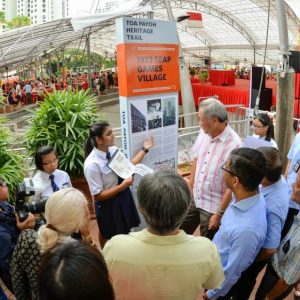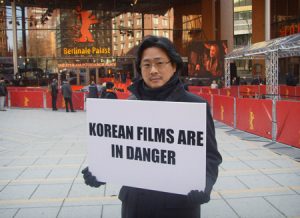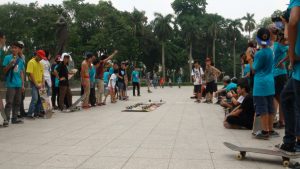We Are Soldiers, Bolting Across the Heavens: Women’s Contradictory Empowerment and Sisterhood in Shirai Yumiko’s “Wombs”
Memo #404 By: Akiko Hirao – akiko.hirao [at] gmail.com Women “pregnant” with the fetus of an alien species that allows them to teleport instantaneously as essential transporters of troops and supplies in a desperate war against oppressors – this is the premise of the award-winning manga by Shirai Yumiko, Wombs. An allegorical tale of conflicting […]
Unfit for Broadcast: The Censorship of K-pop Girl Groups
Memo #401 By: Azalea Lee – azalea [at] mail.ubc.ca With new K-pop girl groups debuting on a seemingly monthly basis, differentiation between groups is often attempted by pushing the sexual envelope—skirts are getting shorter, lyrics are becoming more suggestive, and choreography more risqué. This overexposure is often flagged and ultimately censored by the organizations that […]
The Future of Cambodian Heritage under China
Memo #398 By: Sarah K. Youngblutt – syoungblutt [at] gmail.com Of the 193 States Parties to the UNESCO World Heritage Convention (1972), Italy (with 47), Spain (45), France (42), and Germany (41) had traditionally held the most World Heritage Sites (WHS), with half of all WHS located in Europe and North America. In recent years, China […]
Heritage-Making in Singapore
Memo #397 By: Kelvin E.Y. Low – kelvinlow [at] nus.edu.sg In 2008, the Urban Redevelopment Authority (URA) of Singapore announced that its conservation program would extend beyond buildings to include other landmarks and structures such as bridges, pavilions, and towers that were emblematic of the nation’s history and heritage. Such conservation efforts were to be […]
A New Era for Chinese Cartoons (Manhua)?
Memo #396 By: Nick Stember – nick.stember [at] gmail.com Chinese manhua (literally, ‘casual pictures’) remain virtually unknown in Europe and North America, trailing Japanese manga in popularity even within mainland China. Though China has a long history of satirical cartoons and comic strips going back to the early 20th century, since the 1990s Chinese-originated comics and […]
Local Governments and the Politics of LGBT Issues in Japan
Memo #393 By: Yasuo Takao – Y.Takao [a] curtin.edu.au In Japan, there was a history of open homosexuality as described in literary evidence dating back from the Heian period (794 – 1185). But in the present day, the Japanese legal system has continually ignored sexual minority issues, while not explicitly criminalizing homosexual behavior (except for […]
Multicultural Policy in South Korea and its Implications for Social Inclusion of Multiethnic Youth
Memo #391 By: Léo-Thomas Brylowski – ltbrylowski [at] gmail.com A record number of children born from mixed marriages are starting to make their way through South Korea’s public schooling system since the country’s multicultural turn in 2007. These children represented less than 0.5% of all students enrolled in Korean public schools in 2010, but are […]
Subsidies and the Film Industry: Lessons from France and South Korea
Memo #390 By: Patrick Messerlin – patrick.messerlin [at] gmail.com and Jimmyn Parc – jimmynparc [at] gmail.com With the continued dominance of Hollywood films around the world, policy makers in Asia and elsewhere are increasingly considering government subsidies as a major fuel for strengthening their national film industries. However, the true effectiveness of subsidies on […]
Why should we care about transnational social capital in development cooperation?
Memo #386 By: Rennie J. Moon – rennie.moon [at] yonsei.ac.kr and Gi-Wook Shin – gwshin [at] stanford.edu Higher education aid as transnational social capital Current approaches to higher education aid have focused either on developing human resources or on building social capital in the local context. For instance, donor countries offer various programs to train […]
Skateboarders, traceurs and changes in urban space and social practices in Hanoi
Memo #385 By: Stephanie Geertman – geertman.stephanie [at] gmail.com What can skateboarders and traceurs in Vietnam tell us about new forms of social practice? Skateboarders riding along the base of a statue of Vladimir Lenin in a public park and traceurs climbing and jumping over walls in the newest middle-class communities flanking the city have become […]









